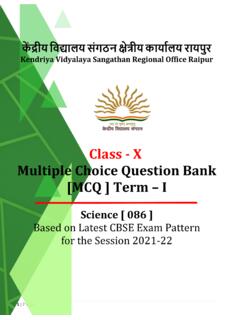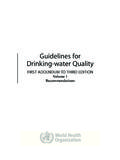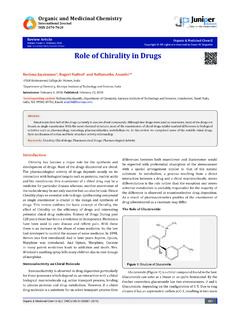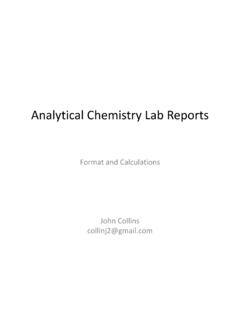Transcription of Class - XII Multiple Choice Question Bank [MCQ ] Term I ...
1 1 CHEMISTRY [ 043 ] Based on Latest CBSE Exam Pattern for the Session 2021-22 Kendriya Vidyalaya Sangathan Regional Office Raipur Class - XII Multiple Choice Question Bank [MCQ ] Term I & Term-II 2 Kendriya Vidyalaya Sangathan Regional Office Raipur MESSAGE FROM DUPUTY COMMISSIONER It is a matter of great pleasure for me to publish study material for different subjects of classes X and XII for Raipur Region. Getting acquainted and familiarized with the recent changes in curriculum and assessment process made by CBSE vide Circular No. 51 and 53 issued in the month of July 2021 will help students to prepare themselves better for the examination. Sound and deeper knowledge of the Units and Chapters is must for grasping the concepts, understanding the questions. Study materials help in making suitable and effective notes for quick revision just before the examination.
2 Due to the unprecedented circumstances of COVID-19 pandemic the students and the teachers are getting very limited opportunity to interact face to face in the classes. In such a situation the supervised and especially prepared value points will help the students to develop their understanding and analytical skills together. The students will be benefitted immensely after going through the Question bank and practice papers. The study materials will build a special bond and act as connecting link between the teachers and the students as both can undertake a guided and experiential learning simultaneously. It will help the students develop the habit of exploring and analyzing the Creative & Critical Thinking Skills. The new concepts introduced in the Question pattern related to case study, reasoning and ascertain will empower the students to take independent decision on different situational problems. The different study materials are designed in such a manner to help the students in their self-learning pace.
3 It emphasizes the great pedagogical dictum that everything can be learnt but nothing can be taught . The self-motivated learning as well as supervised classes will together help them achieve the new academic heights. I would like to extend my sincere gratitude to all the principals and the teachers who have relentlessly striven for completion of the project of preparing study materials for all the subjects. Their enormous contribution in making this project successful is praiseworthy. Happy learning and best of luck! Vinod Kumar (Deputy Commissioner) 3 Kendriya Vidyalaya Sangathan Regional Office Raipur Our Patorn Vinod Kumar Deputy Commissioner KVS RO Raipur Mishra Assistant Commissioner KVS RO Raipur Mishra Assistant Commissioner KVS RO Raipur Shri Rajeev Kumar Singh Principal, Kendriya Vidyalaya SECL Kusmunda,Korba 4 CONTENT DEVELOPMENT TEAM Smt.
4 M. SHARDA RAO, PGT Chemistry, KV NTPC Korba. Smt. FARHANA KHAN, PGT Chemistry, KV BMY Bhilai. Sh. SANTOSH KUMAR CHAINI, PGT Chemistry, KV Raigarh. Sh. WASIM KHAN, PGT Chemistry, KV Dongargarh. Sh. RUDRAKANT JHA, PGT Chemistry, KV Raipur. Sh. JAIRAM KHUTE, PGT Chemistry, KV Kusmunda Korba. Sh. VIJAY KUMAR SAHU, PGT Chemistry, KV Baikunthpur. Sh. MANISH KUMAR GAUTAM, PGT Chemistry, KV Jhagrakhand. Sh. PIYUSH KUMAR, PGT Chemistry, KV Chirimiri. Sh. SHIVSHANKAR MATE, PGT Chemistry, KV Dantewada. Smt. SHEELA CHAKO, PGT Chemistry, KV Durg Smt. N LAKSHMI, PGT Chemistry, KV BILASPUR Sh. SHAILENDRA KUMAR GIRI, PGT Chemistry, KV DHAMTARI TEAM FOR EDITING, COMPILATION AND PREPRATION OF e- Question Bank Sh. J. R. KHUTE, PGT Chemistry, KV No. 3, Korba, SECL Kusmunda Sh. S. D. SARJAL, PGT Chemistry, KV Bilaspur 5 CHEMISTRY Class XII INDEX TERM I Sr. No. Particulars Page No. 1. Details of revised syllabus 2021-22 4-6 2. 1.
5 The Solid State 8-13 3. 2. Solutions 14-19 4. 7. The p-block elements 20-24 5. 10. Haloalkanes and Haloarenes 25-29 6. 11. Alcohols, phenols and ethers 30-35 7. 14. Biomolecules 36-40 INDEX TERM II Sr. No. Particulars Page No. 1. 3. Electrochemistry 42-50 2. 4. chemical Kinetics 51-57 3. 5. Surface chemistry 58-62 4. 8. The d- & -f block elements 63-70 5. 9. Coordination compounds 71-83 6. 12. Aldehydes, ketones and carboxylic acids 84-88 7. 13. Amines 89-107 6 SYLLABUS 2021-22 CHEMISTRY Class - XII Unit I : The Solid states 8 periods Classification of solids based on different binding forces: molecular, ionic, covalent and metallic solids, amorphous and crystalline solids (elementary idea). Unit cell in two dimensional and three-dimensional lattices, calculation of density of unit cell, packing in solids, packing efficiency, voids, number of atoms per unit cell in a cubic unit cell, point defects. Unit II: Solutions 8 Periods Types of solutions, expression of concentration of solutions of solids in liquids, solubility of gases in liquids, solid solutions, Raoul s law, colligative properties - relative lowering of vapor pressure, elevation of boiling point, depression of freezing point, osmotic pressure, determination of molecular masses using colligative properties.
6 Unit VII:p-Block Elements 7 Periods Group -15 Elements: General introduction , electronic configuration, occurrence, oxidation states, trends in physical and chemical properties; Nitrogen preparation properties and uses; compounds of Nitrogen: preparation and properties of Ammonia and Nitric Acid. Group 16 Elements: General introduction , electronic configuration, oxidation states, occurrence, trends in physical and chemical properties, dioxygen: preparation, properties and uses, classification of Oxides, Ozone, Sulphur -allotropic forms; compounds of Sulphur: preparation properties and uses of Sulphur-dioxide, Sulphuric Acid: properties and uses; Oxoacids of Sulphur (Structures only). Group 17 Elements: General introduction , electronic configuration, oxidation states, occurrence, trends in physical and chemical properties; compounds of halogens, Preparation, properties and uses of Chlorine and Hydrochloric acid, interhalogen compounds, Oxoacids of halogens (structures only).
7 Group 18 Elements: General introduction , electronic configuration, occurrence, trends in physical and chemical properties, uses. Unit X: Haloalkanes and Haloarenes. 9 Periods Haloalkanes: Nomenclature, nature of C X bond, physical and chemical properties, optical rotation mechanism of substitution reactions. Haloarenes: Nature of C X bond, substitution reactions (Directive influence of halogen in monosubstituted compounds only). 7 Unit XI: Alcohols, Phenols and Ethers 9 Periods Alcohols: Nomenclature, methods of preparation, physical and chemical properties (of primary alcohols only), identification of primary, secondary and tertiary alcohols, mechanism of dehydration. Phenols: Nomenclature, methods of preparation, physical and chemical properties, acidic nature of phenol, electrophilic substitution reactions, uses of phenols. Ethers: Nomenclature, methods of preparation, physical and chemical properties, uses. Unit XIV: Biomolecules 8 Periods Carbohydrates - Classification (aldoses and ketoses), monosaccharides (glucose and fructose), D-L, configuration Proteins -Elementary idea of - amino acids, peptide bond, polypeptides, proteins, structure of proteins - primary, secondary, tertiary structure and quaternary structures (qualitative idea only), denaturation of proteins.
8 Nucleic Acids: DNA and RNA. Unit III: Electrochemistry 7 Periods Redox reactions, EMF of a cell, standard electrode potential, Nernst equation and its application to chemical cells, Relation between Gibbs energy change and EMF of a cell, conductance in electrolytic solutions, specific and molar conductivity, variations of conductivity with concentration, Kohlrausch's Law, electrolysis. Unit IV: chemical Kinetics 5 Periods Rate of a reaction (Average and instantaneous), factors affecting rate of reaction: concentration, temperature, catalyst; order and molecularity of a reaction, rate law and specific rate constant, integrated rate equations and half-life (only for zero and first order reactions). Unit V: Surface Chemistry 5 Periods Adsorption - physisorption and chemisorption, factors affecting adsorption of gases on solids, colloidal state: distinction between true solutions, colloids and suspension; 8 lyophilic, lyophobic, multi-molecular and macromolecular colloids; properties of colloids; Tyndall effect, Brownian movement, electrophoresis, coagulation.
9 Unit VIII: d and f Block Elements 7 Periods General introduction , electronic configuration, occurrence and characteristics of transition metals, general trends in properties of the first-row transition metals metallic character, ionization enthalpy, oxidation states, ionic radii, color, catalytic property, magnetic properties, interstitial compounds, alloy formation. Lanthanoids - Electronic configuration, oxidation states and lanthanoid contraction and its consequences. Unit IX: Coordination Compounds 8 Periods Coordination compounds - introduction , ligands, coordination number, color, magnetic properties and shapes, IUPAC nomenclature of mononuclear coordination compounds. Bonding, Werner's theory, VBT, and CFT. Unit XII: Aldehydes, Ketones and Carboxylic Acids 10 Periods Aldehydes and Ketones: Nomenclature, nature of carbonyl group, methods of preparation, physical and chemical properties, mechanism of nucleophilic addition, reactivity of alpha hydrogen in aldehydes, uses.
10 Carboxylic Acids: Nomenclature, acidic nature, methods of preparation, physical and chemical properties; uses. Unit XIII: Amines 7 Periods Amines: Nomenclature, classification, structure, methods of preparation, physical and chemical properties, uses, identification of primary, secondary and tertiary amines 9 TERM - I 1. The Solid State MCQs [1 Mark each] 10 1. Which of the following is not true about the ionic solids? (A) Bigger ions form the close packed structure. (B) Smaller ions occupy either the tetrahedral or the octahedral voids depending upon their size. (C) Occupation of all the voids is not necessary. (D) The fraction of octahedral or tetrahedral voids occupied depends upon the radii of the ions occupying the voids. 2. Solid A is very hard electrical insulator in solid as well as in molten state and melts at an extremely high temperature.

![Class - X Multiple Choice Question Bank [MCQ ] Term I](/cache/preview/b/6/7/f/b/d/9/9/thumb-b67fbd9907d87865e135315cd2a39374.jpg)
![Class - X Multiple Choice Question Bank [MCQ ] Term I](/cache/preview/6/4/a/a/2/a/b/6/thumb-64aa2ab628ee91ba2326c975fd6b6d6b.jpg)








